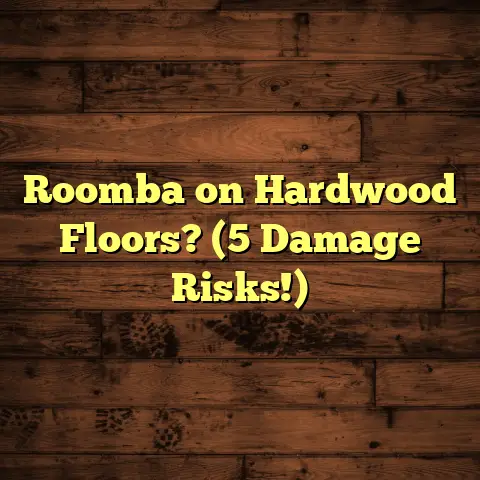Choosing Interior Color Palettes (5 Top Trends!)
Ever stared blankly at a wall, overwhelmed by the sheer number of paint chips? I get it! Choosing the right color palette for your home can feel like a monumental task.
It’s not just about picking pretty colors; it’s about crafting an atmosphere, setting a mood, and creating a space that truly reflects you.
The wrong colors can make a room feel cramped, dreary, or just plain off. But the right palette? Magic! It can transform your house into a haven, a place where you feel happy, relaxed, and inspired.
But where do you even start? That’s where I come in. As a flooring contractor, I’ve seen firsthand how color plays a crucial role in tying a room together.
I’ve witnessed amazing transformations and, let’s be honest, a few color mishaps too! Don’t worry, I’m here to help you navigate the exciting world of interior color.
We’ll dive into current trends, explore the fundamentals of color theory, and equip you with the knowledge to make confident choices.
So, grab a cup of coffee (or tea!), and let’s unlock the secrets to creating the perfect color palette for your home. Ready? Let’s get started!
Section 1: Understanding Color Theory
Okay, before we jump into the latest trends, let’s cover some basics. Think of it as Color Theory 101. Don’t worry, it’s not as intimidating as it sounds!
At its heart, color theory is all about understanding how colors interact with each other. It’s the foundation for creating harmonious and visually appealing spaces.
First, we have the primary colors: red, yellow, and blue. These are the OG colors – they can’t be created by mixing other colors. They are the building blocks of everything else.
Next up are the secondary colors: green, orange, and violet. These are created by mixing two primary colors. Red + Yellow = Orange, Yellow + Blue = Green, and Blue + Red = Violet. Easy peasy!
Then we have tertiary colors. These are made by mixing a primary color with a neighboring secondary color. Think red-orange, yellow-green, blue-violet, and so on. This creates even more subtle variations and complexities.
Now, let’s talk about the color wheel. It’s a visual representation of all these colors, arranged in a circle. It’s an invaluable tool for understanding color relationships.
You’ll notice that the color wheel is divided into warm colors and cool colors. Warm colors (reds, oranges, yellows) tend to evoke feelings of energy, warmth, and excitement.
Cool colors (blues, greens, purples) are often associated with calmness, serenity, and peace. Using these in your space can drastically change the feel of a room.
But it’s not just about aesthetics. Colors also have a psychological effect on us. Studies have shown that certain colors can influence our mood, behavior, and even our physical well-being.
For example, blue is often used in bedrooms because it’s known to promote relaxation and sleep. Yellow can boost your mood and creativity, making it a great choice for a home office or kitchen.
So, how do you actually use this knowledge to create a beautiful color palette? That’s where color schemes come in. Here are a few popular ones:
-
Complementary: Colors that are opposite each other on the color wheel (e.g., red and green, blue and orange). These create high contrast and can be very visually striking.
-
Analogous: Colors that are next to each other on the color wheel (e.g., blue, blue-green, green). These create a harmonious and soothing effect.
-
Triadic: Three colors that are evenly spaced on the color wheel (e.g., red, yellow, blue). These offer a balanced and vibrant look.
Let’s say you want to create a cozy living room. You could use an analogous color scheme with warm colors like yellow, yellow-orange, and orange. Add some textured pillows and a soft rug, and voila! You’ve got a space that’s both inviting and visually appealing.
Or, if you’re feeling bold, you could try a complementary color scheme in your dining room. Imagine deep blue walls with pops of orange in the artwork and accessories. It’s a statement-making look that’s sure to impress.
Understanding color theory is like having a secret weapon in your interior design arsenal. It empowers you to make informed choices and create spaces that are not only beautiful but also functional and emotionally resonant.
Section 2: Trend 1 – Earthy Tones and Natural Shades
Alright, let’s dive into the trends! One of the biggest trends I’m seeing right now is the rise of earthy tones and natural shades. Think terracotta, sage green, muted browns, and warm neutrals.
These colors are all about bringing the outdoors in, creating a sense of calm and connection to nature. After years of stark whites and grays, people are craving warmth and authenticity in their homes.
There’s something incredibly comforting about being surrounded by colors that remind us of the earth. It’s like a visual hug! These tones evoke feelings of stability, grounding, and well-being.
Earthy tones are incredibly versatile. They work well in just about any room, from living rooms and bedrooms to kitchens and bathrooms. They also pair beautifully with a wide range of materials, like wood, stone, and natural fibers.
I recently worked on a project where the homeowner wanted to create a spa-like bathroom. We used a soft sage green on the walls, paired with natural stone flooring and wooden accents. The result was a tranquil oasis that felt both luxurious and inviting.
Another great example is using terracotta in a living room. Imagine terracotta-colored walls, a cozy brown sofa, and some woven baskets filled with greenery. It’s a warm and inviting space that’s perfect for relaxing and entertaining.
Here are a few tips for incorporating earthy tones into your home:
-
Start with the walls: Paint is the easiest and most affordable way to transform a space. Choose a warm neutral or a muted earth tone for a subtle yet impactful change.
-
Add natural textures: Incorporate materials like wood, stone, rattan, and linen to enhance the earthy feel.
-
Bring in greenery: Plants are a must! They add life, color, and a sense of freshness to any room.
-
Accessorize with warm metals: Gold, brass, and copper accents can add a touch of elegance and warmth to your space.
One of the best things about earthy tones is that they’re timeless. They’re not just a fleeting trend; they’re a classic choice that will never go out of style.
According to a recent survey by the National Kitchen and Bath Association (NKBA), earthy tones are among the most popular color choices for kitchens and bathrooms in 2024. This suggests that this trend is here to stay for the foreseeable future.
So, if you’re looking to create a warm, inviting, and nature-inspired home, earthy tones are definitely worth considering. They’re a beautiful and versatile choice that will transform your space into a sanctuary.
Section 3: Trend 2 – Bold and Vibrant Hues
Now, for something completely different! While earthy tones are all about subtlety and calmness, the trend of bold and vibrant hues is all about making a statement.
Think deep blues, rich reds, vibrant yellows, and emerald greens. These colors are not for the faint of heart! They’re designed to grab your attention and inject personality into a space.
After years of playing it safe with neutrals, people are starting to embrace color again. They’re realizing that color can be a powerful tool for self-expression and creating a home that truly reflects their unique style.
Bold colors can be incredibly impactful. They can make a room feel more energetic, exciting, and even luxurious. They can also be used to highlight architectural features or create a focal point.
One of the most popular ways to incorporate bold colors is through accent walls. Painting one wall a vibrant hue can instantly transform a room without overwhelming the space.
I recently helped a client create a home office that was both functional and inspiring. We painted one wall a deep teal color, which created a sense of focus and creativity. We then added some pops of yellow in the artwork and accessories to brighten up the space.
Another great way to use bold colors is in furniture pieces. A bright red sofa or a vibrant yellow armchair can add a fun and unexpected twist to a living room.
I’ve also seen people using bold colors in unexpected places, like painting the inside of a closet or the back of a bookshelf. It’s a subtle way to add a touch of personality without committing to a full-blown color overhaul.
Here are a few tips for using bold colors effectively:
-
Start small: If you’re hesitant to commit to a bold color on the walls, start with smaller accents, like pillows, rugs, or artwork.
-
Balance is key: When using bold colors, it’s important to balance them with neutrals to prevent the space from feeling overwhelming.
-
Consider the lighting: Bold colors can look very different depending on the lighting in the room. Be sure to test the color in different lighting conditions before committing to it.
-
Don’t be afraid to experiment: Color is personal! Don’t be afraid to try new things and see what works for you.
One of the biggest challenges with bold colors is choosing the right shade. There are so many different variations of each color, and it can be difficult to know which one will look best in your space.
My advice is to get a bunch of paint samples and test them out on your walls. Live with them for a few days and see how they look in different lighting conditions.
According to a recent report by Pantone, bold and vibrant colors are expected to be a major trend in interior design for the next few years. This suggests that people are becoming more comfortable with using color in their homes and are looking for ways to express their individuality.
So, if you’re ready to make a statement and add some personality to your home, don’t be afraid to embrace bold and vibrant hues. They’re a fun and exciting way to transform your space and create a home that truly reflects your unique style.
Section 4: Trend 3 – Soft Pastels and Muted Shades
If bold and vibrant isn’t your style, don’t worry! There’s another color trend that’s just as popular: soft pastels and muted shades. Think blush pink, baby blue, muted lavender, and mint green.
These colors are all about creating a serene and tranquil environment. They’re perfect for bedrooms, living areas, and any space where you want to feel relaxed and at peace.
Pastels have been around for a while, but they’re making a major comeback in interior design. After years of harsh, minimalist interiors, people are craving softness and warmth in their homes.
There’s something incredibly soothing about being surrounded by pastel colors. They evoke feelings of calmness, happiness, and nostalgia. They’re also incredibly versatile and can be used in a variety of different styles, from modern to vintage.
One of the most popular ways to use pastels is in bedrooms. Imagine a bedroom with blush pink walls, a soft white bedspread, and some lavender accents. It’s a dreamy and romantic space that’s perfect for relaxation.
I recently worked on a project where the homeowner wanted to create a calming nursery for her baby. We used a combination of baby blue and mint green on the walls, paired with white furniture and soft textiles. The result was a serene and inviting space that was perfect for a newborn.
Another great way to use pastels is in living areas. Imagine a living room with muted lavender walls, a gray sofa, and some blush pink pillows. It’s a sophisticated and elegant space that’s perfect for entertaining.
Here are a few tips for using pastels effectively:
-
Layer pastels with neutrals: Pastels can be a bit too sweet on their own. Layering them with neutrals, like white, gray, or beige, can create depth and interest.
-
Mix and match pastels: Don’t be afraid to mix and match different pastel colors. Just be sure to choose colors that complement each other.
-
Add texture: Texture is key when working with pastels. Incorporate materials like velvet, linen, and wool to add depth and interest to the space.
-
Use metallics: Metallic accents, like gold or silver, can add a touch of glamour to a pastel palette.
One of the biggest challenges with pastels is preventing them from looking too childish or saccharine. The key is to use them in moderation and to balance them with more sophisticated elements.
For example, you could pair blush pink walls with a sleek black sofa and some modern artwork. Or, you could use muted lavender in a dining room with a rustic wooden table and some industrial-style lighting.
According to a recent report by Sherwin-Williams, soft pastels are expected to be a major trend in interior design for the next few years. This suggests that people are looking for ways to create calming and inviting spaces in their homes.
So, if you’re looking to create a serene and tranquil environment, soft pastels and muted shades are definitely worth considering. They’re a beautiful and versatile choice that will transform your space into a peaceful oasis.
Section 5: Trend 4 – Monochromatic Schemes
Let’s move on to something a bit more streamlined: monochromatic color schemes. This involves using different shades, tints, and tones of a single color throughout a space.
It might sound boring, but trust me, when done right, monochromatic can be incredibly chic and sophisticated. The key is to create depth and interest through texture and variations in the color.
The beauty of a monochromatic scheme lies in its simplicity. It creates a sense of harmony and cohesion, making a space feel calm and uncluttered. It’s also a great way to make a small room feel larger, as the continuous color visually expands the space.
One of the most popular monochromatic schemes is using different shades of gray. Gray is a versatile neutral that can be both modern and timeless. You can use light gray on the walls, a darker gray on the furniture, and charcoal gray accents to create a sophisticated and elegant space.
I recently helped a client create a monochromatic living room using different shades of blue. We used a light sky blue on the walls, a navy blue sofa, and some teal-colored pillows and accessories. The result was a calming and inviting space that felt both modern and classic.
Another great example is using different shades of green in a bedroom. Imagine a bedroom with sage green walls, a forest green bedspread, and some olive green accents. It’s a nature-inspired space that’s perfect for relaxation.
Here are a few tips for creating a successful monochromatic scheme:
-
Vary the shades: Don’t just use one shade of the color throughout the space. Vary the shades to create depth and interest.
-
Incorporate texture: Texture is key! Use different textures, like velvet, linen, and wool, to add visual interest to the space.
-
Use metallics: Metallic accents, like gold or silver, can add a touch of glamour to a monochromatic palette.
-
Add a pop of contrast: While the goal is to use one main color, adding a small pop of contrast can make the space feel more dynamic. For example, you could add a yellow pillow to a blue monochromatic living room.
One of the biggest challenges with monochromatic schemes is avoiding monotony. It’s easy for the space to feel flat and uninspired if you don’t pay attention to detail.
The key is to use different shades, textures, and patterns to create visual interest. You could also add some artwork or accessories in a complementary color to break up the monotony.
According to a recent survey by Houzz, monochromatic schemes are becoming increasingly popular, especially in bedrooms and bathrooms. This suggests that people are looking for ways to create calming and minimalist spaces in their homes.
So, if you’re looking to create a sophisticated and harmonious space, a monochromatic color scheme is definitely worth considering. It’s a timeless and versatile choice that will transform your home into a stylish sanctuary.
Section 6: Trend 5 – Eclectic Mixing and Maximalism
Finally, let’s talk about the trend that’s all about breaking the rules: eclectic mixing and maximalism. This is where you throw caution to the wind and mix different colors, patterns, and styles to create a unique and personalized space.
It’s the antithesis of minimalism, and it’s all about embracing your individuality and creating a home that truly reflects your personality.
The key to successful eclectic design is cohesion. While you’re mixing different elements, you need to have a unifying element that ties everything together. This could be a color palette, a style, or a theme.
One of the most common ways to create an eclectic space is by mixing different furniture styles. You could pair a vintage armchair with a modern sofa, or a rustic wooden table with sleek metal chairs.
I recently worked on a project where the homeowner wanted to create an eclectic living room. We mixed a mid-century modern sofa with a bohemian rug, some industrial-style lighting, and some vintage artwork. The result was a unique and personalized space that felt both stylish and comfortable.
Another great way to create an eclectic space is by mixing different patterns. You could pair a floral wallpaper with a geometric rug, or a striped sofa with some polka dot pillows.
Just be sure to choose patterns that complement each other and to balance them with solid colors.
Here are a few tips for creating a successful eclectic space:
-
Choose a unifying element: This could be a color palette, a style, or a theme.
-
Start with a neutral base: Use neutral colors on the walls and floors to create a blank canvas.
-
Mix and match: Don’t be afraid to mix different colors, patterns, and styles.
-
Edit, edit, edit: It’s easy to go overboard with eclectic design. Be sure to edit your space and remove anything that doesn’t fit.
One of the biggest challenges with eclectic design is avoiding chaos. It’s easy for the space to feel cluttered and overwhelming if you don’t pay attention to detail.
The key is to have a clear vision for the space and to carefully curate your collection of items. You should also be sure to leave plenty of negative space to give the eye a place to rest.
According to a recent article in Architectural Digest, eclectic design is becoming increasingly popular, especially among millennials and Gen Z. This suggests that people are looking for ways to express their individuality and create homes that are truly unique.
So, if you’re looking to create a bold and personalized space, eclectic mixing and maximalism are definitely worth considering. It’s a fun and exciting way to transform your home into a one-of-a-kind masterpiece.
Conclusion
So, there you have it! Five top trends in interior color palettes. From the calming embrace of earthy tones to the bold statement of vibrant hues, there’s a color palette out there for everyone.
Remember, the most important thing is to choose colors that you love and that make you feel good in your space. Trends can be a great source of inspiration, but ultimately, your home should be a reflection of your unique style and personality.
Don’t be afraid to experiment, to break the rules, and to create a space that’s truly your own. And if you’re ever feeling overwhelmed, don’t hesitate to reach out to a professional for help.
Whether it’s a flooring contractor like myself or an interior designer, we’re here to help you bring your vision to life. So go forth, embrace color, and create a home that you love! Happy decorating!





